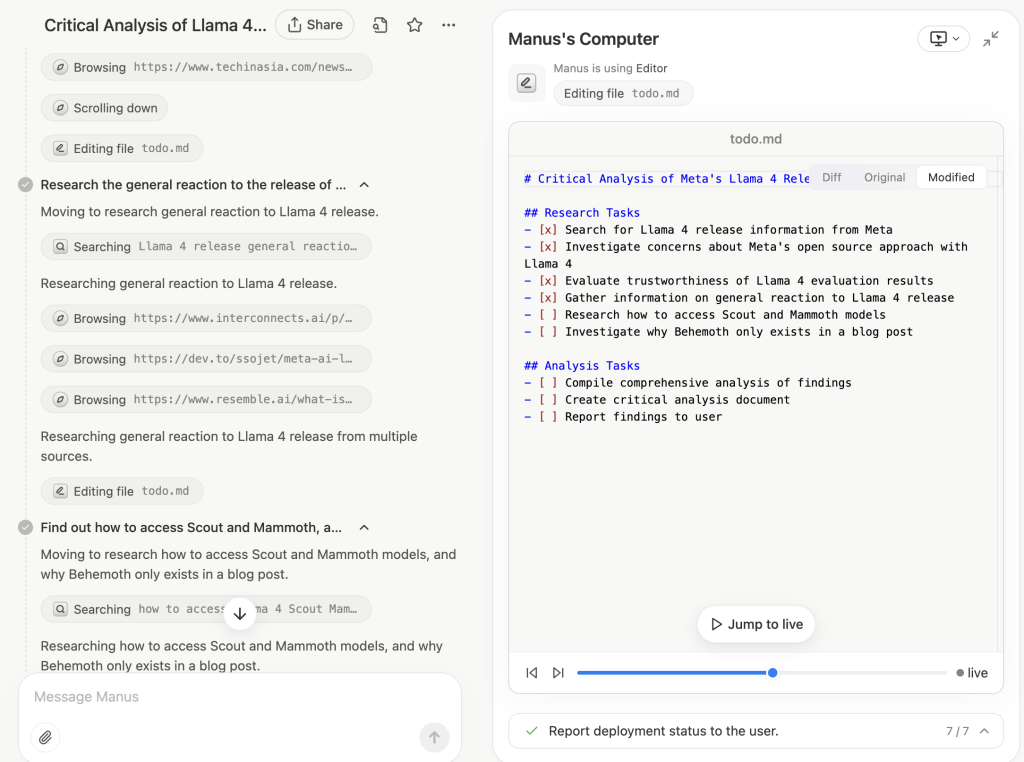The screen flickered as Manus processed my request. Not with the familiar spinning wheel of most AI systems, but with a visible, methodical breakdown of tasks it was completing in real-time. I watched, somewhat mesmerized, as it opened browser windows, scanned research papers, compared technical specifications, and synthesized information—all without me typing another word.
This wasn’t just another AI chatbot. This was something fundamentally different.
After nearly a month on the waitlist, I finally got access. And my first test? A deep dive into Meta’s newly released Llama 4.
The Full Spectrum: Manus’s Capabilities
What is Manus, really? Before conducting my hands-on test, I inquired about its capabilities and received the explanation below. For a more thorough article, visit Manus – Leading the Charge in Autonomous AI.
- Information gathering and research: Manus can search the web, access websites, gather information from multiple sources, fact-check, and create comprehensive documentation.
- Data processing and visualization: It analyzes data, creates charts and visualizations, and processes information in various formats.
- Content creation: Perhaps most impressively, it writes in-depth articles, research reports, and other long-form content with proper citations.
- Development and programming: Manus creates websites, applications, and tools using various programming languages (primarily Python, JavaScript, HTML/CSS).
- Problem-solving: Beyond just development tasks, it uses programming to solve various complex problems.
- Process automation: It helps automate tasks like data collection, information processing, and more.
- Browser-based tasks: Manus navigates websites, interacts with web elements, and helps with web-based workflows.
What makes this list remarkable isn’t just the breadth of capabilities, but how they integrate seamlessly. Traditional AI tools might excel at one or two of these areas, but Manus combines them into workflows that feel genuinely autonomous.
The Task: A Critical Breakdown of Llama 4
I prompted Manus with a multi-faceted, nuanced request:
“Conduct a critical analysis of the newly released Llama 4. What are the concerns regarding Meta’s approach to open-source Llama 4, which differs from previous versions? Are the evaluation results trustworthy, and what is the general reaction to the release of Llama 4? How can you access Scout and Mammoth, and why does Behemoth only exist in a blog?”
Within seconds, Manus spun up a virtual browser session, visibly searching through research papers, developer forums, tech blogs, and news articles. Its interface displayed an evolving To-Do list that updated in real-time:

I stepped away to grab a coffee, and when I got back about fifteen minutes later, Manus had put together a detailed report. Oddly, it was missing direct citations and links – apparently the default setting when not explicitly requested. When I pointed this out, Manus promptly re-generated the report with in-text citations and numbered references, However, the in-text citations weren’t linked, so I requested anchor links to the corresponding references, which Manus then added successfully.
Beyond the report itself, Manus even proposed building a website to present the findings, giving me control over its visibility. The Llama 4 analysis is available here: https://eifrcxtv.manus.space/
AI Moves to the Application Layer
Manus exemplifies a broader shift in AI. While 2023’s AI race focused on bigger, smarter foundation models, 2024 is about practical applications—what these models can actually accomplish in the real world.
Companies across the spectrum are racing to build in this new paradigm:
- OpenAI with its customizable GPTs
- Google with Astra
- Anthropic with Claude Artifacts
- Startups like Cognition with Devin AI and Adept with ACT-1
The future of productivity isn’t just asking an AI for answers—it’s delegating entire workflows and focusing your attention where it matters most. Manus offers a compelling glimpse of this future.
Worth the Wait?
After years of incremental improvements in AI interfaces, Manus feels like a genuine leap forward. The experience of watching an AI agent independently research, analyze, and synthesize information on Llama 4—without constant prompting or hand-holding—was nothing short of remarkable.
Is it perfect? No, the analysis leaned toward critical perspectives without giving equal weight to positive aspects of Llama 4. A more balanced approach would have strengthened the analysis by acknowledging both strengths and weaknesses more evenly. And there is still trust but verify element – it didn’t adequately verify the credibility of some sources, particularly Reddit posts claiming insider information about benchmark manipulation. These claims should have been presented with more explicit caveats about their unverified nature. But the core promise—AI that works autonomously on complex tasks—is undeniably delivered.
For knowledge workers drowning in information overload, tools like Manus don’t just offer incremental efficiency gains; they fundamentally transform how we approach complex problems.
After my month on the waitlist, I can confidently say: If this is where AI agents are headed, the next wave of productivity tools won’t just assist us—they’ll truly work alongside us.
And that future can’t come soon enough.